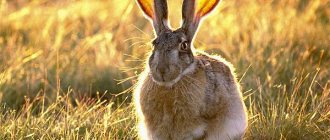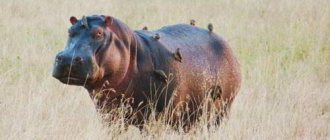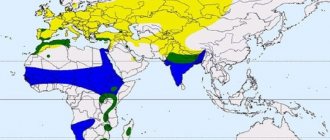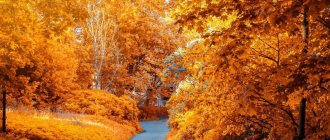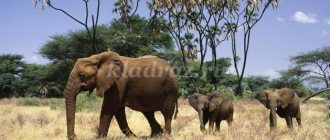Summary of a lesson on speech development in the middle group. Wild animals
Abstract of the educational activity on speech development “Journey to the forest to see wild animals” for children of the middle group (age from 4-5 years)
Author: Oksana Viktorovna Borodina, teacher of the highest qualification category MBDOU “Combined kindergarten No. 21”, Amursk, Khabarovsk the edges. Description of the material: I offer you a summary of direct educational activities for children of the middle group (age 4 to 5 years) on the topic “Journey to the forest to see wild animals.” This material will be useful to teachers of the middle group on the use of symbols - prepositions and on working with the picture-graphic plan of a chain organization. Objectives: 1. Teach children to use prepositions with spatial meaning in speech, relying on prepositional symbols. Improving the grammatical structure of speech (composing a simple sentence with visual support). Continue to teach children to accurately, consistently, coherently and grammatically correctly retell a short story based on the pictorial and graphic plan of the chain organization, to build complete sentences. Practice agreeing verbs with nouns in gender, number and case using a mnemonic table. Reinforce the pronunciation of the sound [s] in words and phrases. Promote the formation of correct posture, prevent flat feet, and improve “snake” running between objects. 2. Develop skills in the use of the simplest forms of symbolization, symbolic designation of objects when performing tasks; develop the ability to properly regulate the tempo and strength of your voice; coordination of speech with movement, motor activity, coherent speech. 3. Formation of interest in wildlife, goodwill, and cooperation skills. Equipment: cards of symbols-prepositions, mnemonic table, pictures of wild animals, pictures (drifts, branches, hollows, dens, winter trees), presentation, laptop, projector, graphic plan for retelling, bricks, skittles, ribbed path, arc, “Bunny dance "(music by Zheleznova), chest, cabbage, fish, barrel of honey, envelope with letter, magnetic board, magnets. Preliminary work: looking at pictures of wild animals, reading fairy tales, stories about wild animals in winter, learning the physical exercise “Bunny Dance” (music by Zheleznova); acquaintance with preposition symbols, mnemonic table. Integration of educational areas: physical development, artistic and aesthetic development (music), cognitive development (E)
Progress of the GCD
Organizational moment: Like there is snow on a hill, snow And under the hill there is snow, snow And a bear sleeps under the snow Quiet, quiet, don’t make noise. Letter Teacher: “Hello, guys! Old man Lesovichok gave us his chest, but we just can’t open it. Come quickly and help out the forest animals.” Educator: Sonya, where do wild animals live? (in the forest) Educator: Well, should we go into the forest and help out the animals? So we got ready for the journey, set off into the winter forest. The path is interesting, everything is good for health. (walking)
We walk through the snowdrifts, raising our legs.
(walking with a high hip lift)
And on the ice we walk quietly and easily
(walking on toes)
.
“It’s not so easy to get through here, the tunnel lies here on the way” (Climbing under the arch)
“And here is the bridge and everyone can walk along the bridge beautifully, I walk along the bridge, holding my arms to the sides.”
(Walking on a ribbed board)
“We will put our feet together and begin to jump like hares.”
(Jumping over bricks)
So as not to fall through the trees and bushes in the snow, we will rush merrily.
(running like a snake)
“Our legs are not tired, we will stretch a little.”
(Breathing exercise) Educator: So we came to the forest, but for some reason there was no one, the animals were probably scared of us and hid, and where now we find out Game with prepositions “Bridge” (the bridge will be a preposition diagram, you need to connect the words in the pictures with the help of a bridge - a preposition, so that a sentence is formed, and we find out where someone is hiding)
preposition symbols:,: under, behind, over, on, about, between
Children make up sentences one by one: “The fox is hiding behind the spruce tree.”
"The squirrel is hiding in a tree." "The hare is hiding under a bush." "The bear is hiding in a den." "The wolf is hiding between the snowdrifts." Educator: So we found all the animals. Come out and don't be afraid of us! (animals come out: bear, fox, bunny) Educator: Let's praise the little fox: Speech gymnastics. Su-su-su - I saw a fox in the forest. Sy-sy-sy - the fox has a beautiful tail, Sa-sa-sa - that's a beautiful fox. We pronounce the clear phrase with different voice strengths (quietly-louder-louder, quickly and slowly).
Where is your chest?
The animals show the chest Educator: Guys, I know the magic words, repeat after me: Chick, chuk, chuck, chock - open, chest! Let's do it together! (the teacher looks into the chest)
.
Educator: Guys, how many gifts Lesovichok has prepared for the animals here. Educator: Let's make friends with animals ICT Working with a mnemonic table Agreement in gender, number and case
Educator: Let's dance with the little bunny Dynamic pause “Dance the little bunny” (music by Zheleznova) Compiling a story for a chain organization according to a picture and graphic plan: Educator: Listen, guys, what happened one day to the little bear. The teacher reads the story: “THE BEAR CUB AND THE COCK” 1. One day a hunter found a bear cub in the forest. 2. He brought the bear cub to the village. 3. In the village, the hostess began to look after him. 4. She had a bully rooster. 5. One day he fluffed his wings and chased the animal. 6. Out of fear, the bear cub hid in the doghouse. Questions 1. Who did the hunter find in the forest? 2. Where did he bring the bear cub? 3. Who in the village began to look after him? 4. Who lived with the landlady? 5. What did the rooster do? 6. Where did the bear cub hide? (according to the degree of answers to questions, children come out one at a time and display pictures on a graphic panel)
Then, one child composes the entire story, and the others evaluate the resulting story according to the scheme of raising the sun or cloud
(if the story did not work out)
.
After the children’s retelling, the teacher asks a problematic question.
Educator: Oleg, what do you think about the hunter’s action? (children's answers) Educator: absolutely right, the hunter did very well, because in the winter, without his parents, the little bear cub died. It turns out that the hunter, who went hunting to kill animals, saved the life of the bear cub. Educator: How do you think animals fare in winter? Educator: Yes, it’s hard for animals in winter, they don’t have enough food and we have to help them, like the old man Lesovichok did, he made the best gift for the animals, he left them food. Educator: What did we do in class today? (performed different tasks, played...)
- Which tasks turned out to be difficult for you?
— What helped you complete this or that task? (diagram, model) Educator: What did you understand from the story about the bear cub? (you need to help even wild animals and not leave them in trouble)
Presentation on the topic: Wild animals
We recommend watching:
Summary of a lesson on speech development in the middle group on the topic: “Ukraine is my native land” Summary of a lesson on environmental education in the junior group on the topic: “Journey to a wonderful forest” Short-term project in the senior group of a preschool educational institution. Wild animals Summary of educational activities on forest animals for children of the younger group of preschool educational institutions
Similar articles:
Summary of a lesson on speech development in the middle group on the topic “Our Street”
LiveInternetLiveInternet
Quote from Tatyana57
Read in full In your quotation book or community!
SPEECH DEVELOPMENT. LEXICAL TOPIC “WILD BEASTS OF OUR FORESTS AND THEIR CHILDREN”
CHILDREN SHOULD KNOW THE NOUNS: bear, she-bear, bear cub, wolf, she-wolf, cub, hare, hare, little hare, fox, fox, fox, fox, hole, lair, squirrel, squirrel, hollow, moose, elk, calf, horns, hedgehog , hedgehog, hedgehog, wild boar, female boar, boar, badger, badger, little badger, forest, clearing, cheat, paw, wool, claws, nose, ears, hooves, tail. Muzzle, snout, mouth, animals, cubs, bushes, trees, mouse, lynx, raccoon, beaver, deer, marten, fangs, sable, mink, mole, den, connecting rod. ADJECTIVES: brown, clubfooted, cunning, predatory, gray, tireless, scary, thick (fur), red, wild, fluffy, dexterous, careful, fast, white, cowardly, long-eared, lop-eared, sensitive (ears), oblique, timid, velvet, prickly, wolf, striped. VERBS: wanders, climbs, roars, tears (bast), jumps, gallops, growls, grins. Hunts, escapes, howls, gnaws, digs, runs, “gave a go,” collects, stores, grunts, sniffs, sniffs, listens, hides, pricks, sneaks, sucks, lies down, falls. CHILDREN SHOULD BE ABLE TO NAME THE FAMILY: Bear, she-bear, little bear. Hare, hare, little bunny... SELECT NOUNS TO ADJECTIVES: Brown, club-footed, clumsy -... Gray, toothy, scary -... Cunning, fluffy, red-haired -... CALL MOM: The bear's cub, the fox's cub..., the bunny's... WHO HAS A VOICE : The fox yelps, the bear growls, the wolf howls... WHO LIVES WHERE: A fox lives in a hole. In the den - ... In the den - ... In the hollow - ... TO WHOM WE WILL GIVE WHAT: Meat - to the wolf, raspberries - ..., honey - ..., carrots - ..., nuts - ... SELECT NOUNS TO THE VERB: Hunts - ... Sneaks - ... Howls - ... Bites - ... Jumps - ... Tricks - ... Waddles - ... SELECT SIGNS: Wolf (which one?) -.... Fox (what?) - ... Hedgehog (what?) - ... SELECT ACTIONS: Bear (what is he doing?) - ... Fox (what is he doing?) - ... Hare (what is he doing?) - ... CORRECTLY ANSWERING THE QUESTIONS: Whose? WHOSE? WHOSE? WHOSE? Track - wolf, fox, hare... Ears - bear, hare, squirrel... Head - elk, hedgehog, wolf, fox... FORM NEW WORDS USING PRESIDENTS: Walks - moves, leaves, goes around, passes, enters, enters, descends, finds , leaves, approaches, reaches, comes, leaves, passes. COMPLETE A DESCRIPTIVE STORY ACCORDING TO PLAN. What is the name of? Where does he live? What kind of home does he have? What is the appearance? What habits? What does it eat? How does it get food? What are his enemies? How to defend yourself? What is the cub's name?
The fox is a predator. The fox mainly hunts mice, gophers, and less often hares. The fox cunningly catches hedgehogs. She rolls the hedgehog to the water, he straightens his spines in the water and swims to the shore. This is where the fox is waiting for him. The fox lives in a hole, and in the spring the fox gives birth to cubs. The squirrel is a rodent. She eats nuts, berries, mushrooms, and pine cones. The squirrel has sharp claws. This helps her quickly climb the tree. The fluffy tail serves as a parachute for the squirrel. A squirrel lives in a hollow and insulates its nest with down. In summer the squirrel is red, and in winter it is gray. In winter, the squirrel sleeps almost all the time and rarely looks out of the hollow. The squirrel is a thrifty housewife. She prepares nuts for the winter and dries mushrooms on tree branches. In the spring, squirrels give birth to squirrels. The wolf is a predatory animal. Wolves live in a pack. A pack is a wolf family. Wolves almost always hunt for sick, weak animals. Wolves hunt at night. Wolves live in a den to raise wolf cubs; wolf cubs appear in the spring. The bear is an omnivore. He loves to eat honey, berries, fish, ants, roots, but can also attack humans. The bear is clumsy in appearance, but easily climbs trees and runs quickly. The bear builds a den for himself from twigs, fallen trees, and moss. In winter, a mother bear gives birth to cubs. If a bear has accumulated little fat since the fall, it wakes up in the winter and walks through the forest hungry. For this the bear was nicknamed the connecting rod. The hare is a rodent. The hare feeds on grass, leaves, shrub bark, mushrooms, and roots. In winter, it chews the bark of trees. The hare is white in winter and gray in summer. This helps him hide from predators. Long, fast legs also save the hare from its enemies. The hare runs up the mountain at a run, and down the mountain somersaults. The hare lives under a bush in the summer, and digs a hole in the snow in the winter. In the spring, the hare gives birth to baby hares.
EXERCISE “GUESS AND TELL”. This beast lives in the forest, gnaws the bark of the trunks. In the summer in a gray fur coat, and in the winter in a white one. (Hare) - What does the hare eat in the spring? (grass, leaves). The owner of the forest wakes up in the spring, and in winter, to the howl of a blizzard, he sleeps in a snowy hut. (Bear) -What does a bear eat? (roots, grass, beetles, mice, hares). You and I recognize the animal by these two signs: He wears a gray fur coat in the winter, and a red fur coat in the summer. (Squirrel) - What does a squirrel feed on? (cones, nuts). All winter between the Christmas trees I slept through a bag of needles. “F-f-f-f—stop sleeping, It’s time to get up!” (Hedgehog) - What does a hedgehog eat? (bugs, worms, mice). Gray and toothy. Howls on a rainy day: “Uh-uh...” (Wolf) - What food does a wolf eat? (meat - catches mice, hares, sheep). Fluffy tail, golden fur, lives in the forest, steals chickens in the village. (Fox) - Who else does the fox catch? (mice, hares).
